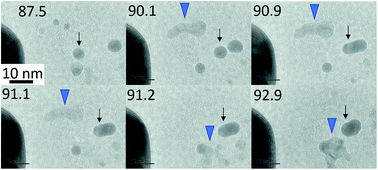Possible embryos and precursors of crystalline nuclei of calcium carbonate observed by liquid-cell transmission electron microscopy†
Abstract
Several different building blocks or precursors play an important role in the early stages of the crystallization of calcium carbonate (CaCO3). Many studies have been conducted over a long period to elucidate the fundamental processes involved in this crystallization. Here, we report the role of an amorphous phase and embryo at the beginning of the nucleation of CaCO3 from solutions of relatively low supersaturation. Prenucleation crystals formed in amorphous calcium carbonate (ACC) at a significantly large formation rate of 2 × 1022 m−3 s−1, suggesting that a low interfacial energy exists between the ACC and crystals. Only one calcite crystal exceeded the size for a critical nucleus (∼104 molecules) in 150 pre-nucleation crystals. Each pre-nucleation crystal might consist of a different polymorph, and ACCs have a similar composition and structure. A particle-detection algorithm, used in conjunction with machine learning, suggested that an embryo with a characteristic structure exists in solution and might play a crucial role in nucleation. No similar embryonic structure could be observed immediately after the dissolution of pre-nucleation particles, implying that their dissolution process is not simply the reverse process of their growth. This method should provide a new approach to understanding nucleation processes.

- This article is part of the themed collection: Understanding Crystallisation


 Please wait while we load your content...
Please wait while we load your content...